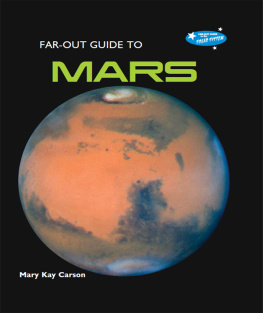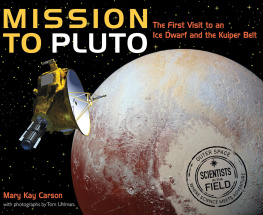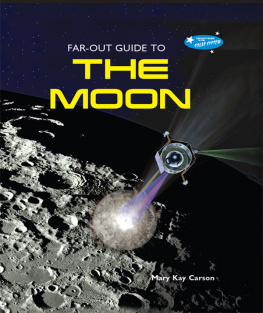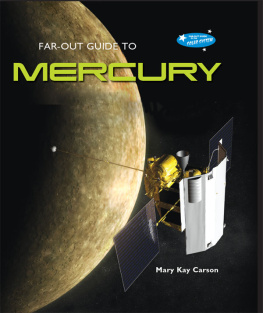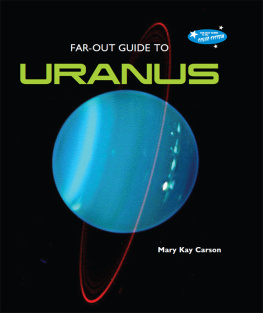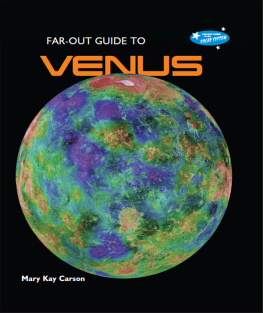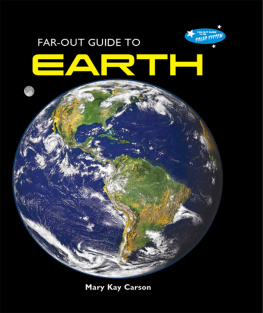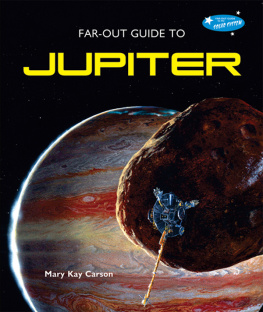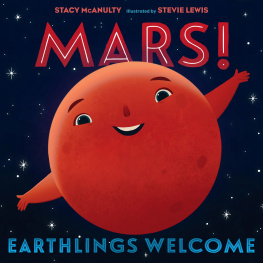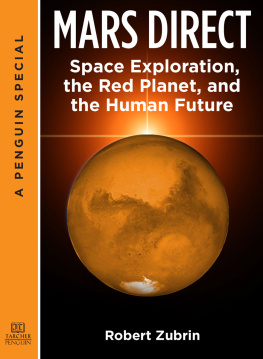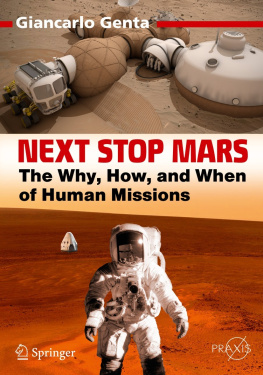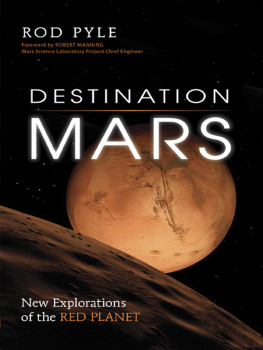
RED PLANET
EARTH'S NEIGHBOR MARS likely once had an environment that could have supported life. Now it has underground frozen water in many places. How do we know this?
Spacecraft from Earth have visited Mars and taught us a lot about this dusty red planet. Learn about the amazing missions, the dedicated scientists who plan them, and more far-out facts about the fourth planet from the Sun.
The Far-Out Guide to the Solar System series provides valuable information about the solar system, its planets, and mankind's quest in exploring them. This series is an excellent resource for young scientists and amateur astronomers.
Bahram Mobasher, PhD, Series Science Consultant
Professor of Physics and Observational Astronomy, University of California, Riverside
About the Author
Award-winning author MARY KAY CARSON has written many nonfiction books for young people and their teachers. In 2009, she received the American Institute of Aeronautics and Astronautics Children's Literature Award.
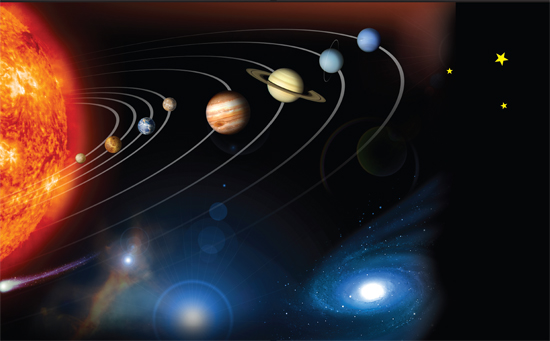
Image Credit: NASA/JPL
Mars is the fourth planet from the Sun. (Note that the planets distances are not shown to scale.) It is about half the size of Earth.
Did you know that it snows on Mars? Crystals of water icesnowfall from Marss thin clouds. How do we know this? A robotic lander called Phoenix saw snow falling on Mars in 2008. You will learn lots more far-out facts about Mars in this book. Just keep reading!
Mars seems familiar these days. Pictures of Mars are often in the news and on TV. Most of us recognize Marss rust-colored, desert-like landscape when we see pictures of it. Mars is a bit like the bottom of the ocean or Antarctica. You know what it looks like, even though you have never been there.

Image Credit: NASA/JPL
The sand and rocky cliffs of Mars are not that different from what you might see on parts of Earth. This is Victoria Crater, near Marss equator.
A fleet of robotic spacecraft have made Mars familiar to us. They send back pictures of rocky hills and frosty plains under a pink sky. The Mars Exploration Rovers Spirit and Opportunity have spent more than six years roaming the planet. And when Phoenix landed on Mars, an orbiting space probe photographed it parachuting down toward the surface. Mars is a busy place!
These robotic explorers are the latest of the dozens of space probes sent to Mars in the past fifty years. More will be traveling to Mars in years to come. Today Mars is a chilly, dusty desert with underground ice and not much air. But scientists believe that long ago Mars was wetter and warmer. Young Mars was more like Earth. Could life of some kind have once lived on Mars? If so, did it leave fossils behind? Do microbes still survive somewhere on the Red Planet? Our neighbor world may turn out to be even more familiar than we think.
FAR-OUT FACT
Mars is often called the Red Planet. The Romans named it after their war god, Mars, because of its bloody color. The fourth planet from the Sun looks reddish, even in the night sky. Marss red color comes from the rusted iron in its dusty surface soil. Dust in the air even makes the sky pinkish orange.
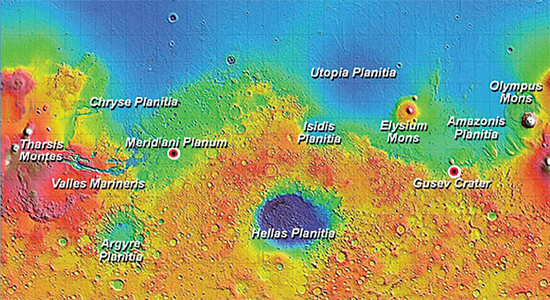
Image Credit: NASA/JPL/ASU
This map of Mars is color-coded. Mountaintops are white, like the volcano Olympus Mons on the right. High areas are yellow and red. Low areas are green and blue. The lowest places are dark blue, like the giant impact crater Hellas Planitia in the center. The landing sites of the Mars Exploration Rovers (MERs) are marked with red dots. Opportunity landed at Meridiani Planun (middle left) and Spirit at Gusev Crater (middle right).
What would a must-see tour of Mars include? Olympus Mons would make the list. It is the biggest volcano in the solar system. Another place is Valles Marineris. It is a canyon system that makes the Grand Canyon look like a ditch. Hellas Planitia is a 2,300-kilometer- (1,400-mile-) wide crater on Mars. Asteroids and comets crashing into the planet created Marss many bowl-shaped craters.

Image Credit: NASA
The volcano Olympus Mons is 2 times taller than Mt. Everest and is as wide as the state of Missouri.
Marss canyons, plains, volcanoes, and craters are more than stunning sites. Marss features hold clues to a long lost history. They are left from a time when lava burst from volcanoes, asteroids rained down, and water flowed on the planets surface. Studying the rocks in canyons and craters can tell us what a place was like when they formedwhether on Mars or Earth. Scientists are finding out about Marss watery past by studying its rocks. Two rock-hunting discoverers are the robotic rovers Spirit and Opportunity.
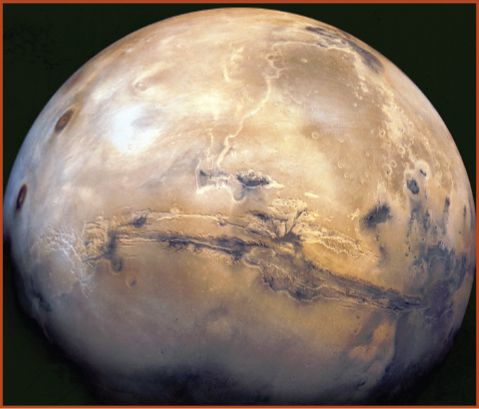
Image Credit: NASA/USGS
The long slash across most of the side of Mars shown in this picture is Valles Marineris. It is a deep canyon system nearly as long as the width of the United States.
The Mars Exploration Rover (MER) Opportunity arrived on January 24, 2004, at a place called Meridiani Planum. Low, flat plains on Mars are called planums. Scientists think that water once covered Marss low plains. The MER team sent Opportunity to Meridiani Planum because an orbiting space probe had spotted hematite there. Hematite is a dark mineral that usually forms in watery places, like seas, lakes, or hot springs.
It was a gamble, admitted Steve Squyres. He is the scientist in charge of the MER mission. But we had a hint, visible from orbit, that this was a place where water might have once been. Fortunately for the MER team, Opportunity was one lucky rover. The spacecraft that set it down on Mars, its lander, put Opportunity in a perfect place. [W]e rolled right into a little 20-meter [65-foot] impact crater, said Squyres. Craters are great places to look for clues to a planets past. They are blasted-out holes that reveal buried layers of rock. Those rocks hold a record of what Meridiani Planum was like long ago.
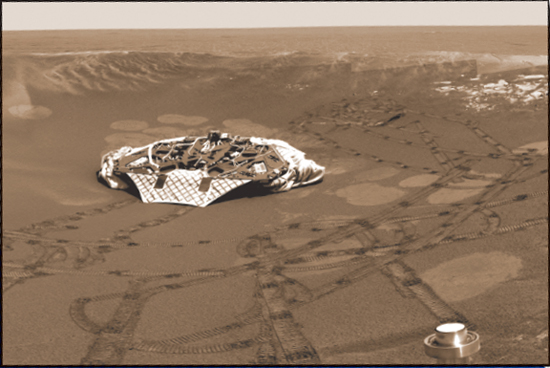
Image Credit: NASA/JPL/Cornell
As Opportunity drives away, it looks back and sees its lander. The airbags that once surrounded the lander have deflated. They bounced and rolled Opportunity into this crater. Can you see all the rover tracks in the sand?
Opportunity studied the craters rocks. Right away it discovered something new. The first microscope picture it took of nearby soil showed odd, tiny round things. When Opportunity roved over to the crater wall it saw them there, too. The balls of hard mineral were stuck in the rock, like blueberries in a muffin, said Squyres. The Martian blueberries turned out to be mostly hematite.
Next page
